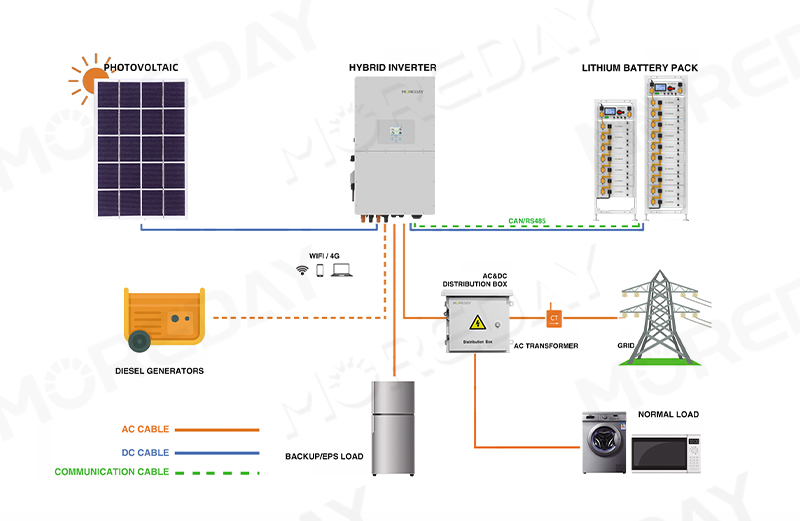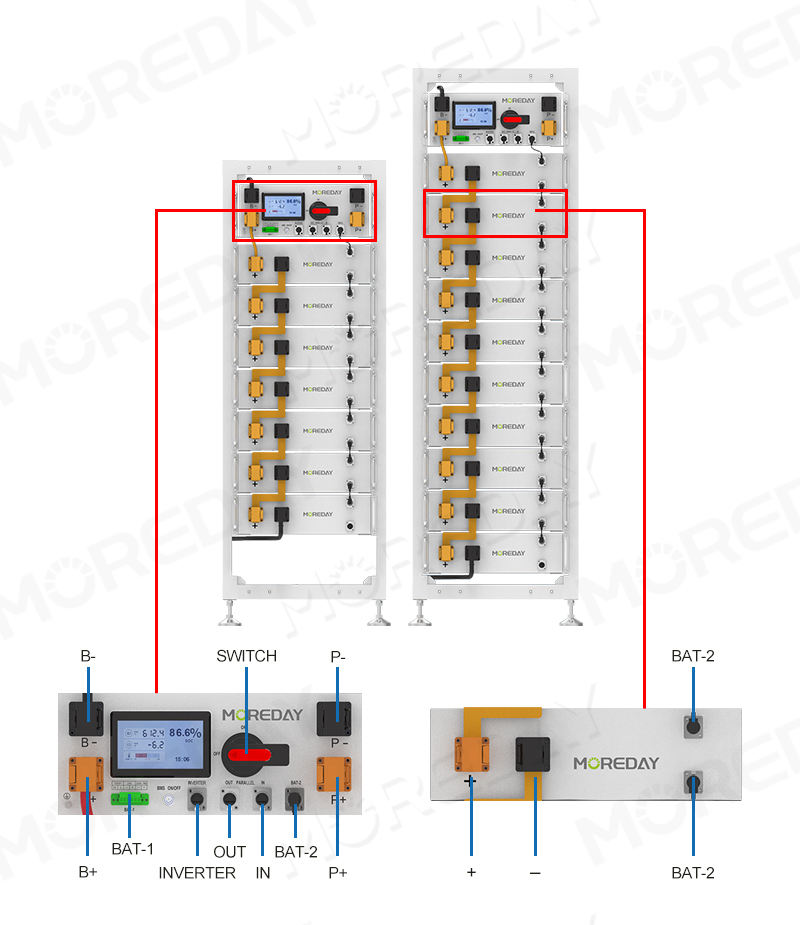As global energy consumption continues to rise, businesses, institutions, and industrial facilities around the world are rethinking how they produce, store, and use energy. At the heart of this transformation lies commercial energy storage — a technology that empowers enterprises to reduce costs, enhance efficiency, and secure a path toward sustainable development.
This article explores in depth what commercial energy storage is, how it works, and why it’s becoming a vital part of the modern energy ecosystem. We’ll also look at how MOREDAY, as a leading provider of smart solar and energy storage solutions, is contributing to this growing sector.

Table of Contents
Toggle1. Understanding Commercial Energy Storage
Commercial energy storage refers to systems designed to store electrical energy for use by commercial or industrial entities. These systems typically consist of large-capacity lithium-ion or lithium iron phosphate (LiFePO₄) batteries, advanced power conversion systems (PCS), and intelligent energy management software.
Unlike small-scale residential storage systems, which power households, commercial systems handle significantly higher loads — supporting offices, factories, data centers, retail complexes, hospitals, and public infrastructure.
At its core, commercial energy storage performs three essential functions:
Energy shifting – storing cheap electricity during low-demand hours and discharging it during peak periods to reduce energy bills.
Peak shaving – reducing the maximum power drawn from the grid, which helps lower demand charges imposed by utilities.
Backup power – providing reliable electricity during grid outages or instability.
These functions not only help enterprises cut operational costs but also enhance energy reliability and sustainability.

2. How Commercial Energy Storage Works
A typical commercial energy storage system includes several interconnected components:
Battery Module: The energy storage unit, often using LiFePO₄ chemistry for its high safety and long life cycle.
Battery Management System (BMS): Monitors voltage, temperature, and current to ensure optimal performance and prevent failures.
Power Conversion System (PCS): Converts AC power from the grid into DC for charging and vice versa for discharging.
Energy Management System (EMS): The “brain” that coordinates charging, discharging, and grid interaction based on load demands and pricing signals.
When integrated with solar photovoltaic (PV) systems, the storage unit captures excess solar energy generated during the day. Instead of feeding it all into the grid, the stored energy can be used later — such as at night or during peak tariff hours.
This integrated setup, known as a solar + storage system, allows commercial users to achieve greater energy autonomy and improved return on investment (ROI).
3. Applications and Scenarios
Commercial energy storage can be applied across a wide range of industries and infrastructure types. Some of the most common include:
a. Industrial Manufacturing
Factories with heavy machinery and fluctuating loads benefit greatly from storage systems that stabilize voltage and reduce peak demand charges.
b. Office Buildings and Commercial Complexes
In urban centers, where electricity prices can vary by time of day, storage enables time-of-use optimization and uninterrupted power for elevators, lighting, and servers.
c. Data Centers
With the explosive growth of cloud computing, energy storage provides a stable and redundant power source to prevent data loss or downtime.
d. Retail and Hospitality
Hotels, malls, and supermarkets use storage to maintain 24/7 operations, manage demand fluctuations, and integrate renewable energy.
e. Public Infrastructure and Schools
Municipal buildings and educational institutions use energy storage to reduce grid dependency and promote sustainable practices.
4. Key Advantages of Commercial Energy Storage
1. Cost Savings
By performing peak shaving and load shifting, businesses can significantly lower their electricity bills. Many regions have demand-based tariffs, where even brief spikes in usage result in higher charges — storage helps smooth out those spikes.
2. Energy Security
Commercial storage provides uninterrupted backup power during outages or grid instability, protecting sensitive equipment and operations.
3. Grid Independence
When combined with on-site solar, enterprises can achieve partial or even full independence from the public grid — a step toward true energy resilience.
4. Sustainability
Energy storage accelerates the transition toward cleaner power by allowing greater use of renewable sources such as solar. This reduces reliance on fossil fuels and contributes to lower carbon emissions.
5. Smart Management
Modern storage systems are integrated with intelligent control algorithms, enabling predictive energy use, automatic switching, and real-time monitoring via cloud platforms.
5. MOREDAY’s Approach to Commercial Energy Storage
MOREDAY, as a trusted global brand in solar and energy solutions, is committed to developing scalable and intelligent commercial storage systems that meet diverse energy demands.
Our commercial and industrial (C&I) storage portfolio includes both high-voltage and low-voltage solutions, designed to deliver stable, safe, and efficient energy management.
For instance, our HV280R Series — with voltage configurations ranging from 358.4V to 716.8V and capacities up to 280Ah — is engineered for large-scale facilities and grid-tied applications. These systems use LiFePO₄ battery technology, ensuring excellent thermal stability and long cycle life.
Meanwhile, our low-voltage 5K–25K modules are ideal for medium-sized businesses, offering flexible installation options and seamless integration with PV systems.
You can explore these solutions further on our MOREDAY Energy Storage Page
.
By integrating our storage units with smart controllers and combiner boxes, MOREDAY helps businesses achieve greater energy efficiency, cost control, and environmental responsibility.

6. Commercial Energy Storage vs. Residential Storage
While both types share the same core technology, their scale, design, and objectives differ:
| Feature | Commercial Energy Storage | Residential Energy Storage |
| Capacity | Typically 50 kWh – >1 MWh | 5 kWh – 20 kWh |
| Purpose | Demand management, cost reduction, grid support | Backup power, solar self-consumption |
| Users | Factories, offices, malls, public buildings | Individual households |
| Control System | Advanced EMS with remote management | Basic inverter control |
| Return on Investment | Based on electricity cost optimization | Based on energy independence and self-use |
Commercial systems are designed for economic optimization, whereas residential ones focus more on comfort and independence. However, both contribute to the global shift toward decentralized energy.
7. The Future of Commercial Energy Storage
The market for commercial energy storage is growing rapidly. According to BloombergNEF, global installations are expected to exceed 500 GWh by 2030, driven by:
Falling battery costs
Expanding renewable energy integration
Government incentives for green infrastructure
Corporate sustainability goals
We are entering an era where energy storage becomes as essential as generation itself. In the coming years, we can expect more hybrid systems combining solar, storage, and EV charging — a complete ecosystem enabling real-time energy optimization.
MOREDAY continues to innovate across these fields, aiming to deliver intelligent, modular, and high-performance storage solutions that empower commercial customers globally.
8. Conclusion
Commercial energy storage is more than just a backup system — it is the foundation of a smarter, cleaner, and more efficient energy future. From cost reduction to energy security and sustainability, its benefits extend far beyond economics.
For enterprises pursuing low-carbon development, integrating storage with renewable energy is no longer optional — it’s strategic.
MOREDAY is proud to be part of this transformation, providing comprehensive solar + storage solutions that help businesses achieve true energy independence and operational excellence.

FAQ: Commercial Energy Storage
1. What types of batteries are used in commercial storage systems?
Most systems today use LiFePO₄ (Lithium Iron Phosphate) batteries due to their high safety, long lifespan, and stable performance.
2. How long can a commercial energy storage system operate during an outage?
That depends on the system’s capacity and load demand. Typical setups can provide several hours to full-day backup power.
3. Can commercial storage work without solar panels?
Yes. While it’s often paired with PV systems, storage can function independently for load management and peak shaving.
4. What’s the difference between AC-coupled and DC-coupled systems?
AC-coupled systems connect through an inverter to the AC grid, while DC-coupled systems link directly to solar arrays — improving efficiency and reducing conversion losses.
5. Is commercial storage scalable?
Absolutely. Modular designs like MOREDAY’s HV280R Series allow users to expand capacity as energy needs grow.
6. What kind of maintenance is required?
Modern systems require minimal maintenance — primarily firmware updates, periodic inspections, and ensuring a clean, ventilated installation environment.
7. Are there government incentives for commercial storage?
Many regions offer tax credits, subsidies, or preferential tariffs to encourage businesses to adopt renewable energy and storage technologies.
8. How does storage contribute to grid stability?
Storage systems can discharge energy during peak hours and absorb excess power during low demand, balancing the grid and preventing blackouts.
9. What’s the typical ROI for a commercial storage project?
Depending on electricity tariffs and usage patterns, payback periods typically range from 3 to 6 years, after which savings become pure profit.
10. How can I choose the right system for my business?
Consider your load profile, available space, and integration goals. Consulting with professionals like MOREDAY ensures a system optimized for your operational and financial objectives.

